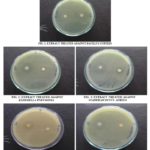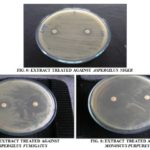ANTIMICROBIAL ACTIVITY OF METHANOLIC EXTRACT OFCISSUS PALLIDA
HTML Full TextANTIMICROBIAL ACTIVITY OF METHANOLIC EXTRACT OFCISSUS PALLIDA
A. Tamil Selvan * 1, Ruman Yezdhani 1, N. Siva Subramanian 1, M. Rama Devi 1, B. Sree Giri Prasad 1, Santhosh Kumar 2 and Sudha Parimala 3
Department of Pharmacology 1, Teegala Krishna Reddy College of Pharmacy, Medbowli, Meerpet, Saroornagar (M), Hyderabad - 500097, Andhra Pradesh, India.
Department of Biochemistry 2, PSG College of Arts and Science, Coimbatore - 641014, Tamil Nadu, India.
Department of Pharmacognosy 3, RBVRR Women’s College of Pharmacy, Hyderabad - 500027, Andhra Pradesh, India.
ABSTRACT: Herbs have been widely used for centuries as remedies for diseased human conditions as they have certain phytochemicals of diseases curing nature. The present study explains the antimicrobial (antibacterial & antifungal) potential of dried stem wood of Cissuspallida methanolic extract against bacterial strains of Bacillus subtilis, Klebsiella pneumonia, Staphylococcus aureus, Escherichia coli, Pseudomonas aureginosa, and Aspergillus niger, Aspergillus fumigates, Monoscus purpure fungal strains by Disc diffusion method. The test extract was compared with Ciprofloxacin 5 μg for bacterial organisms and Fluconazole 20 μg for fungal organisms. The extract showed significant antibacterial and antifungal activity which was confirmed by the zone of inhibition studied.
| Keywords: |
Cissus pallida, Methanolic extract, Antibacterial, Antifungal, Disc diffusion, Ciprofloxacin, Fluconazole
INTRODUCTION: Humankind has been subject to infection by microorganisms since before the dawn of recorded history. One presumes that humankind has been searching for suitable therapy for nearly as long. This was a desperately difficult enterprise given the acute nature of most infections and the nearly total lack of understanding about their origins that was prevalent until the last century. One can find indications in old medical writings of folkloric use of plant and animal preparations, soybean curd, moldy bread and cheese, counter infection with other microbes.
The slow development of public health measures, and an understanding of the desirability of personal cleanliness, but these factors were erratically and inefficiently applied and, when they were applied, often failed 1. Until the discovery of bacteria 300 years ago and the subsequent understanding of their role in infection about 150 years ago, there was no hope for rational therapy.
Until, recently, chemotherapy of fungal infections has lagged far behind chemotherapy of bacterial infections. This lack of progress has resulted, in part, because the most common fungal infections in humans have been relatively superficial infections of the skin and mucosal membranes and potentially lethal deep-seated infections have been quite rare 2. The number of effective antimicrobials available is quite small compared to those available to treat bacterial infections, but research in this area is quite active 3.
Several new agents have been introduced in the last few years. In the present study, Cissus pallida4 methanolic extract of its stem wood was screened against certain gram-positive, gram negative and fungi organisms to evaluate its antimicrobial potential.
MATERIALS AND METHODS:
Collection of Plant Material: The stem and wood part of Cissus pallida was collected from Nallamalla forest region, Kurnool, Andhra Pradesh in June. Plant material was thoroughly washed with water to remove adhered particles and debris and shade dried. The air-dried plant was powdered using Pulveriser and passed through sieve no.20. The plant specimens were identified and authenticated by Dr. Madhava Chetty, Assistant Professor, Department of Botany, S.V. University Tirupathi, Andhra Pradesh, India.
Extraction: About 1 kg of powdered plant material was extracted by Soxhlet extractor using methanol as a solvent. Percentage of the extract was determined. The extract was dried under reduced pressure using rotator vacuum evaporator afforded semisolid extract 5.
Phytochemical Analysis: The methanolic extract was subjected to systematic qualitative phytochemical screening to identify the phytoconstituents 6.
Antimicrobial Screening:
Microorganism Strains: Bacterial strains of Bacillus subtilis, Klebsiella pneumonia, Staphylococcus aureus, Escherichia coli, Pseudomonas aureginosa, and Aspergillus niger, Aspergillus fumigates, Monoscus purpures fungal strains were sued for the study. Ciprofloxacin and Fluconazole were used as the standard drugs.
Preparation of the medium: Peptone: 0.6g%, Tryptone: 0.4g%, Yeast extract: 0.3g%, Beef extract: 0.15g%, Dextrose: 0.1g%, Agar: 1.75g%, Distilled water q.s to 100 ml. The pH of the medium was adjusted to 6.5 - 6.6 before autoclaving the media. The media was autoclaved at 15lb of pressure per square inch at 121 °C for 15 min. A stock solution of the respective plant extract at the concentration of 100 g/ml was prepared using 10% DMSO for the samples. Stock solutions were diluted further with DMSO.
10% DMSO was used as the control. Then the antimicrobial activities of the extracts of different concentration and standard drug ciprofloxacin, Fluconazole were determined by the conventional disc diffusion method against different strains. For the sensitivity test, the wells were filled with different concentrations of the extracts. Then the plates were incubated at 37 °C. After 24 ere determined by measuring the zone of inhibition. The results (zone of inhibition) obtained were mean of three readings in each case 7.
RESULTS AND DISCUSSION: The extract showed significant antimicrobial action against the organism used by disc diffusion methods. The organisms Bacillus subtilis, Klebsiella pneumonia, Staphylococcus aureus, Escherichia coli, Pseudomonas aureginosa were shown 10, 11, 10, 9, 10/100μgm of disc compared with ciprofloxacin 5μgm/disc and Aspergillus niger, Aspergillus fumigates, Monoscus purpures fungal strains shown 8, 11, 11/100μgm of disc of the extract compared with Fluconazole 20 μgm/disc. The zone of inhibition was shown in the Fig. 1-8.
Herbs and herbal materials were the potential useful lead for the development of novel chemotherapeutic agents. The in-vitro screening was the primary step in the screening of the novel chemotherapeutic agents.
TABLE 1: ANTIBACTERIAL ACTIVITY OFCISSUS PALLIDA EXTRACT
| S. no. | Organisms | Ciprofloxacin
(5μg/disc) |
Cissus pallida
(100μg/disc) |
| 1 | Bacillus subtilis | 14 mm | 10 mm |
| 2 | Klebsiellapneumoniae | 15mm | 11mm |
| 3 | Staphylococcus aureus | 20 mm | 10 mm |
| 4 | Escherichia coli | 17 mm | 9 mm |
| 5 | Pseudomonas aureginosa | 20 mm | 10 mm |
The spectrum of activities of the herb majorly due to the presence of phytoconstituents in the particular plant used as a health remedy in the folklore medicine. Phyto molecules from the herb can be used as antimicrobials for the treatment of various microbial infections. Natural products with different medicinal herbs were used in the folk practice to prevent microbial infections 8.
Figures Showing the Zone of Inhibition of Extract and the Standard:
TABLE 2: ANTIFUNGAL ACTIVITY OF CISSUS PALLIDA
| S. no. | Organisms | Standard Fluconazole (20µg/disc) | Cissus pallida (100μg/ disc) |
| 1 | Aspergilus niger | 9 mm | 8 mm |
| 2 | Aspergilus fumigatus | 19 mm | 11 mm |
| 3 | Monoscus purpures | 20 mm | 11 mm |
Figures Showing the Zone of Inhibition of Extract and the Standard:
CONCLUSIONS: Herbs are an important source of potentially useful structures for the development of new chemotherapeutic agents. The primary step towards this research is the in-vitro antibacterial activity assay.
The broad spectrum antibacterial activities of the plant extract, possibly due to the identified phytoconstituents, further confirm its use as a health remedy in traditional medicine. Bioactive substances from the natural sources can be used in the antimicrobial agents for the treatment of various microbial infections.
ACKNOWLEDGEMENT: Nil
CONFLICT OF INTEREST: Nil
REFERENCES:
- Chavan R and Khadke A: Synthesis and biological evaluation of novel indolylisoxazoline derivatives as analgesics and anti-inflammatory agent. Asian Jou of Chemistry 2011; 24(5): 258.
- Harmalkar M and Desai P: Comparative assessment of the antibacterial activity of Ginger extracts with antimicrobial Int J Pharmacol Bio Sci 2011; 5(2), 33-38.
- Prabhakar: Synthesis and Biological Activity of Novel Thiazolidinediones. Bioor Med Che Let 1998; 8: 2725-2730.
- Fernandez G and Banu P: Medicinal properties of Plants from genus Cissus - An Overview. J of Medicine and Plant Research 2012; 6(16): 3080-3086.
- Harbone JB: Phytochemical Methods. A Guide to Modern Techniques of Plant Analysis, London, Chapman and Hall, 1998; 62 - 68.
- Kokate CK, Purohit AP and Gokhale SB: Pharmacognosy, 3rd Nirali Prakashan, Pune. 1995: 290-298.
- Elias G and Rao M: Synthesis and Antiinflammatory activity of Substituted (E)-4-phenyl-3-buten-2-ones, E J Med Chem 1988; 23: 379-380.
- Rani P: Synthesis and antiinflammatory activity of hetero-cyclic indole derivatives. Eur J of Me Che 2004; 39: 449-452.
How to cite this article:
Selvan AT, Yezdhani R, Subramanian NS, Devi MR, Prasad BSG, Kumar S and Parimala S: Antimicrobial activity of methanolic extract of Cissus Pallida. Int J Pharmacognosy 2014; 1(9): 592-95. doi: 10.13040/IJPSR.0975-8232.1(9).592-95.
This Journal licensed under a Creative Commons Attribution-Non-commercial-Share Alike 3.0 Unported License.
Article Information
7
592-595
705
2032
English
IJP
A. T. Selvan *, R. Yezdhani, N. S. Subramanian, M. R. Devi, B. S. G. Prasad, S. Kumar and S. Parimala
Department of Pharmacology, Teegala Krishna Reddy College of Pharmacy, Medbowli, Meerpet, Saroornagar (M), Hyderabad, Andhra Pradesh, India.
tamilselvanpharmacologist@gmail.com
15 July 2014
18 August 2014
28 August 2014
http://dx.doi.org/10.13040/IJPSR.0975-8232.IJP.1(9).592-95
01 September 2014





